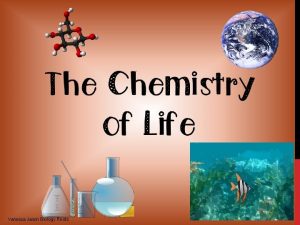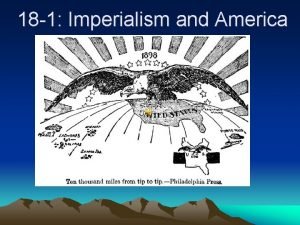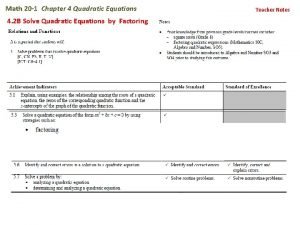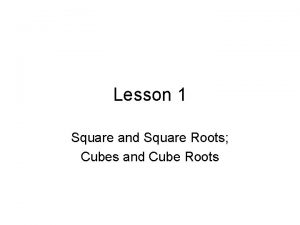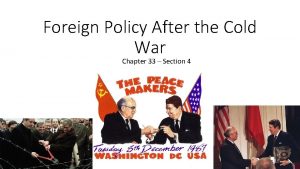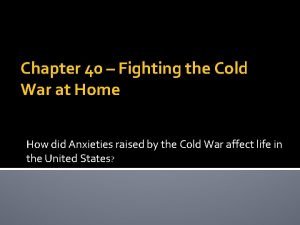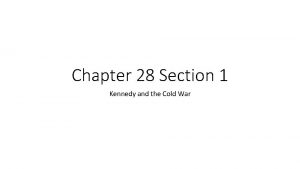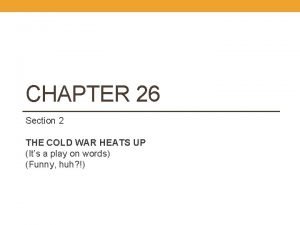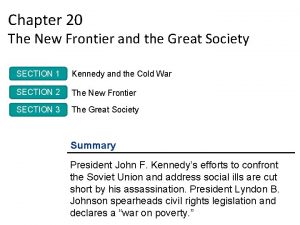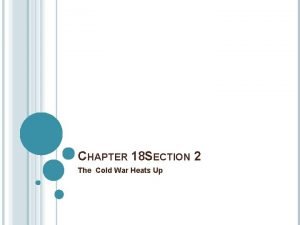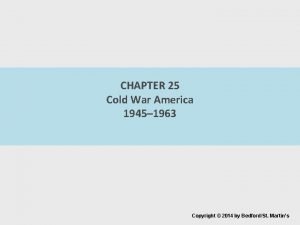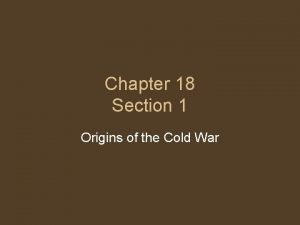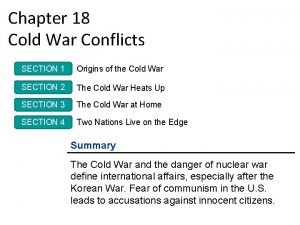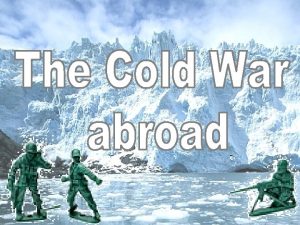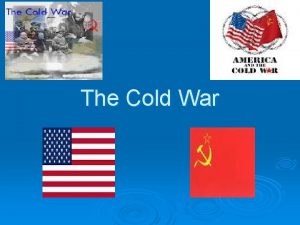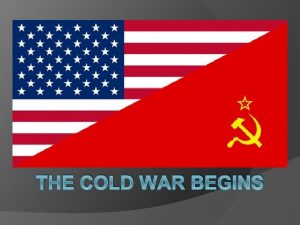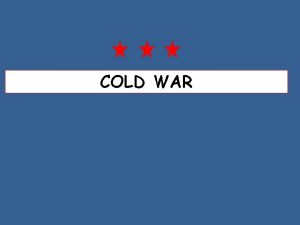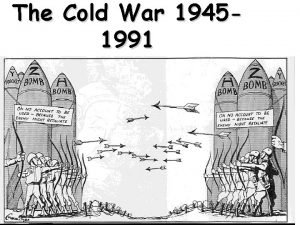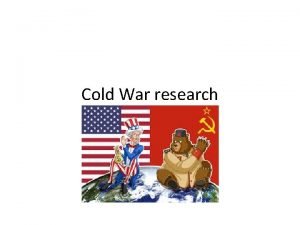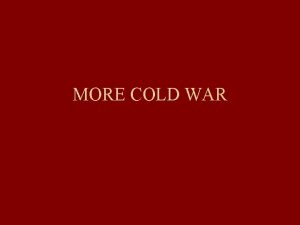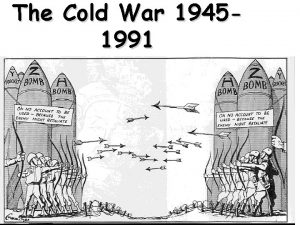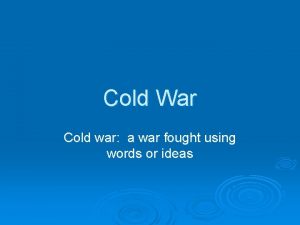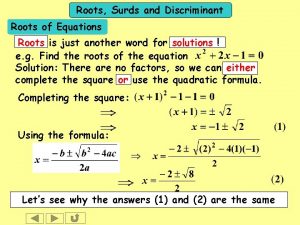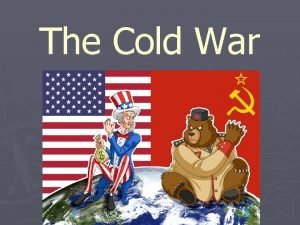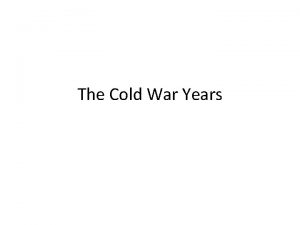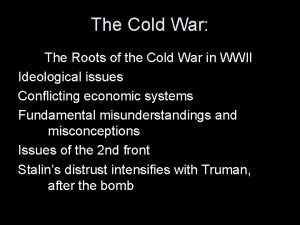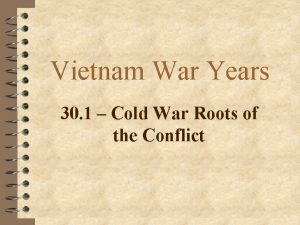Chapter 25 Cold War Roots of the Cold



















- Slides: 19

Chapter 25 Cold War

Roots of the Cold War • United States and Soviet Union relations break down.

American and Soviet Systems Differ • Unified by their opposition to Nazi Germany • Soviet Union: communism, totalitarian dictatorship • United States: free-enterprise capitalism, republic

Allies Disagree on Future of Eastern Europe • Stalin: “keep Germany weak and divided, control Soviet Union. ” • Agreed to establish broadly representative governments and free elections in Eastern Europe and to divide Germany only temporarily into zones of occupation. • satellite states are the countries that remained occupied by the Soviet Union at the end of World War II and had their governments replaced by governments based on the Soviet model. • Stalin failed to keep his promise that free elections would be held in Poland, Czechoslovakia, Hungary, Romania, and Bulgaria. Instead, communist governments were established in all those countries, noncommunist political parties were suppressed, and genuinely democratic elections were never held. • United States and Great Britain sought a stronger, united Germany and independent nations in Eastern Europe.

Truman and Stalin Clash at Potsdam • Remember the Yalta Conference which they refer to • The Yalta Conference took place in a Russian resort town in the Crimea from February 4 -11, 1945, during World War Two. At Yalta, U. S. President Franklin Delano Roosevelt, British Prime Minister Winston Churchill, and Soviet Premier Joseph Stalin made important decisions regarding the future progress of the war and the postwar world. • It had already been decided that Germany would be divided into occupied zones administered by U. S. , British, French, and Soviet forces. The conferees accepted the principle that the Allies had no duty toward the Germans except to provide minimum subsistence, declared that the German military industry would be abolished or confiscated, and agreed that major war criminals would be tried before an international court, which subsequently presided at Nürnberg. The determination of reparations was assigned to a commission. • How to deal with the defeated or liberated countries of eastern Europe was the main problem discussed at the conference. The agreements reached, which were accepted by Stalin, called for “interim governmental authorities broadly representative of all democratic elements in the population…and the earliest possible establishment through free elections of governments responsive to the will of the people. ”

Truman and Stalin Clash at Potsdam • The Potsdam Conference was a meeting of the Soviet Union, the United Kingdom and the United States in Potsdam, Germany from July 17 to August 2, 1945. The Prime Minister of the United Kingdom (Winston Churchill), the President of the United States (Harry S. Truman) and the leader of the USSR (Joseph Stalin) met to talk about Germany on July 1945 and were going to discuss what should happen to it now that the Second World War was over. • The first conference was held at Yalta, but the allies did not agree on anything very important. However, a lot had happened since the Yalta Conference. Firstly, the USA had a new president named Harry Truman. He was much tougher on Communism than the previous president, Roosevelt, had been. This was a problem for Stalin. Also, Churchill had been voted out and was replaced by Clement Attlee. Stalin saw himself as far more experienced than these new leaders. Stalin also caused trouble, as some of what the allies agreed on at Yalta was that Poland should have a neutral government. Stalin had killed the neutral government leaders and replaced them with ones that would listen to him. This meant that there were a lot of problems at Potsdam.

• Agreements • The allies talked about and agreed that: • �Germany would be split up into four different pieces (occupation zones), one occupied by France, one by the USSR, one by the USA and one by Britain • �Nazi criminals would be judged and sentenced • Disagreements • • • The allies talked about but did not agree on: How to separate Germany How much money Germany should pay to the winners of the war How Stalin was treating Poland How much land Poland should have

• Truman left Potsdam thinking the Soviet Union was planning “World conquest”.

Meeting the Soviet Challenge • Churchill traveled by train with President Harry Truman to make a speech. • On March 5, 1946, at the request of Westminster College in the small Missouri town of Fulton (population of 7, 000), Churchill gave his now famous "Iron Curtain" speech to a crowd of 40, 000. • In this speech, Churchill gave the very descriptive phrase that surprised the United States and Britain, "From Stettin in the Baltic to Trieste in the Adriatic, an iron curtain has descended across the Continent. “

Meeting the Soviet Challenge cont. • East of that curtain the Soviet Union was gaining more control by installing communist government and police states and by crushing political and religious dissent. • Churchill feared spread of communism Western Europe and East Asia.

Truman Faces a Crisis • 1947 no issue was more wighty then the growing crisis between the United States and Soviet Union. • European and Asian countries struggling against communist movements supported by the Soviets. • IE: Greece and Turkey

The Truman Doctrine Opposes Communist Expansion • Addressed congress pertaining to the Greek and Turkish • Requested money from Congress to support free peoples who are resisting attempted subjugation (conquest) by armed minorities or by outside pressure. • Truman Doctrine • His promise to aid nations struggling against communist movements and set a new course for American foreign policy.

Containing Soviet Expansion • Foreign Affairs George Kennan an American diplomat and a leading authority on the Soviet Union. • Article was a blue print for the American policy that became known as containment because its goal was to keep communism contained within its existing borders.

Kennan Argues for Containment • Contended that Stalin wanted to expand but would not pose risk.

The Marshall Plan Aids Europe Economies • Containment policy first great success was in Western Europe. • Secretary of State George C. Marshall unveiled a recovery plan for Europe. • the United States gave $13 billion (approximately $130 billion in current dollar value as of August 2015) in economic support to help rebuild European economies after the end of World War II. The plan was in operation for four years beginning in April 1948.

The Cold War Heats Up • Front lines located in Germany. • Zones controlled by France, Britan, and the U. S. were combined to form West Germany. • West Germany was bordered on the east by the Soviet controlled East Germany. • Allies also controlled the western part of Berlin.

Berlin Airlift Saves West Berlin • The city of Berlin was an island in the middle of the Soviet controlled zone. The west sent supplies there via railroads and roads. However, the Soviets wanted total control of Berlin. They figured if they cut off Berlin from their external supplies and food, then it would fall under their control. • On June 24, 1948 the Soviets blocked all rail and road traffic to Berlin. They cut off the electricity coming from the Soviet part of the city. They halted all traffic going in and out of the city. The only way in was to fly. • When the blockade first started, the city of Berlin had around 36 days worth of food. They also needed tons of coal for energy and other items such as medical supplies. • Without going to war or giving up the city of Berlin, the only option the western countries had was to try and fly in all the supplies. This was a huge task. There were over two million people living in the city at the time. The army estimated that it would take over 1500 tons of food each day to keep them alive. • The Soviets did not believe that an airlift would work. They felt that the people of Berlin would eventually give up. • Over the next ten months the United States and Great Britain flew around 277, 000 flights into Berlin. They carried over 2. 3 million tons of supplies into the city. On May 12, 1949 the Soviet Union stopped the blockade and the airlift was over.

Cold War Rivals Form Alliances • The Berlin airlift demonstrated that Stalin could be contained if Western nations were prepared to take forceful actions. • The North Atlantic Treaty Organization was created in 1949 by the United States, Canada, and several Western European nations to provide collective security against the Soviet Union. NATO was the first peacetime military alliance the United States entered into outside of the Western Hemisphere.

• Warsaw Pact • Response to NATO the Soviet Union and its satellite states formed a rival military alliance. • Communist states of Eastern Europe except Yugoslavia were members.
 Lesson 1 the origins of the cold war
Lesson 1 the origins of the cold war Proxy wars in the cold war
Proxy wars in the cold war Biology roots vanessa jason
Biology roots vanessa jason Perfect squares 1-10000
Perfect squares 1-10000 Lesson 3 existence and uniqueness
Lesson 3 existence and uniqueness The roots of american imperialism economic roots
The roots of american imperialism economic roots Sum of the roots and product of the roots formula
Sum of the roots and product of the roots formula Cubed numbers list
Cubed numbers list Chapter 30 the war to end war
Chapter 30 the war to end war Chapter 30 the war to end war
Chapter 30 the war to end war Chapter 33 section 4 foreign policy after the cold war
Chapter 33 section 4 foreign policy after the cold war Chapter 17 section 1 cold war two superpowers face off
Chapter 17 section 1 cold war two superpowers face off Chapter 40 fighting the cold war at home
Chapter 40 fighting the cold war at home Chapter 28 section 1 kennedy and the cold war
Chapter 28 section 1 kennedy and the cold war Chapter 26 section 2 the cold war heats up
Chapter 26 section 2 the cold war heats up Chapter 20 section 1 kennedy and the cold war
Chapter 20 section 1 kennedy and the cold war Chapter 18 section 2 guided reading the cold war heats up
Chapter 18 section 2 guided reading the cold war heats up Chapter 25 cold war america
Chapter 25 cold war america Chapter 18 section 1 origins of the cold war
Chapter 18 section 1 origins of the cold war Origins of the cold war chapter 18 section 1
Origins of the cold war chapter 18 section 1


